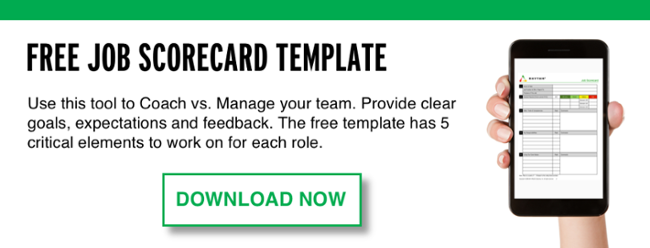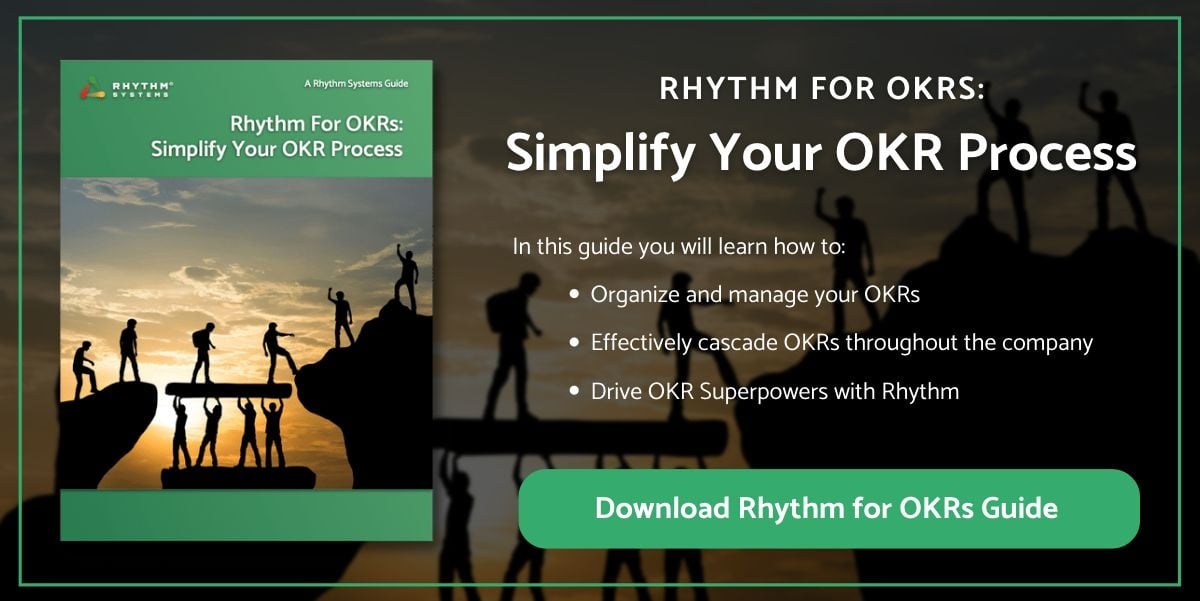What Are Objectives And Key Results (OKRs)?
Objectives and Key Results (OKRs) are a goal-setting framework used to set measurable objectives and track progress toward achieving them. OKRs help teams identify where they want to be in the future and measure their success along the way. An OKR consists of an objective, a project or task that needs to be completed, and key results, which are measurable outcomes that contribute to the objective's success.
OKRs are commonly used in large organizations and can be adapted for smaller companies. For staffing firms specifically, OKRs can provide a way to measure progress toward goals and create a culture of accountability. Here are some staffing OKR examples that you can use to start setting your objectives and key results.
The Strategic Edge: Why OKRs Matter
Staffing firms operate in a high-stakes environment. Targets must be hit, talent matched accurately, and client satisfaction maintained. Here's where Objectives and Key Results (OKRs) come into play:
Focus and Clarity
OKRs set a clear direction. Everyone knows the priorities, reducing wasted efforts on non-impactful activities. OKRs (Objectives and Key Results) can be an effective staffing tool to help organizations create a clear direction and focus their efforts on activities with the most impact. By setting OKRs, organizations can ensure everyone is working towards the same strategic goals and objectives. This makes it easier for teams to align their projects and tasks with the greater organizational mission.
Alignment and Engagement
With OKRs, teams align toward common goals. This unity boosts morale and engagement, which are vital in a service-driven industry like staffing. Staffing companies have embraced OKRs to improve efficiency, enhance customer satisfaction, and increase profitability. These objectives are achievable by setting measurable goals for recruitment teams regarding filling positions quickly and with high-quality candidates.
Tracking Progress
They enable precise tracking. You can't manage what you don't measure, and OKRs provide that critical visibility. Staffing OKRs are a great way to ensure that teams are appropriately staffed and equipped to meet their goals. They enable precise tracking and visibility into the progress of hiring. They can be used to measure performance against key objectives related to staffing, such as increasing diversity or reducing time-to-hire.
Stretch Goals Encourage Ambition
OKRs aren't just about hitting targets and striving for more. They encourage teams to reach beyond their comfort zones. OKRs are a great way to motivate teams and help them stay focused on the most critical objectives. Effective OKRs should be measurable, attainable, and relevant to your organization’s mission.
Crafting Effective Staffing OKRs: A How-To Guide
Writing OKRs isn't about lofty aspirations; it's a tactical move. In this blog article, I will provide a quick overview of how to implement OKRs, and you can click on the link to get the complete implementation guide. Here's the formula for crafting effective staffing OKRs:
Start with the Objective
Your objective is your mission – qualitative and inspiring. It should resonate with your team and be easily communicated.
Define Key Results
These are your signposts, quantitative and time-bound. They'll tell you if you're on the path to achieving your objective.
Commit and Calibrate
Commit to your OKRs, but stay flexible. As the market changes, your OKRs may need tweaks.
Review and Reflect
Regular check-ins are essential. They keep everyone accountable and focused on the end goal.
Staffing OKR Examples to Guide Your Firm
Here's a practical take on how OKRs can look in the staffing world:
Objective: Amplify Client Acquisition
Key Results:
- Secure 20 new client contracts this quarter.
- Increase client outreach engagements by 30%.
- Boost proposal conversion rate by 15%.
Objective: Enhance Candidate Placement Quality
Key Results:
- Achieve a 95% satisfaction rate from placed candidates.
- Reduce time-to-hire by 25%.
- Ensure 90% of placements exceed the 90-day retention mark.
Objective: Optimize Operational Efficiency
Key Results:
- Cut down recruitment cycle time by 20%.
- Implement a new CRM system by Q2.
- Achieve a 10% reduction in operational costs through process improvements.
Objective: Elevate Brand Presence in the Staffing Industry
Key Results:
- Increase website traffic by 40% through targeted content.
- Grow LinkedIn followers by 25%.
- Secure three speaking engagements at industry conferences.
Objective: Foster Team Development and Retention
Key Results:
- Launch a professional development program with 85% team participation.
- Achieve less than 10% staff turnover this year.
- Score an average of 4.5/5 on employee satisfaction surveys.
Objective: Improve recruitment effectiveness
Key Results:
- Reduce time-to-fill vacancies by 60%.
- Increase offer acceptance rate by 50%.
- Improve new hire quality by 60%.
- Fostering Employee Engagement:
Objective: Foster employee engagement.
Key Results:
- Raise employee satisfaction by 20%.
- Lower turnover rate by 40%.
- Achieve 85% participation in recognition and rewards program.
Engaged employees are more productive, motivated, and loyal. By setting these OKRs, staffing firms can focus on creating a positive work environment, reducing turnover, and implementing recognition and rewards programs to enhance employee engagement.
Objective: Develop leadership capabilities.
Key Results:
- Measure a 20% increase in leadership effectiveness.
- Promote internal candidates to 40% of leadership roles.
- Receive an average rating of 8 in 360-degree feedback assessments.
Nurturing strong leadership is essential for the growth and success of staffing firms. By setting these OKRs, firms can focus on developing leadership skills, promoting internal talent, and receiving feedback to improve leadership effectiveness.
Objective: Enhance performance management.
Key Results:
- Establish goal alignment of 60%.
- Boost average performance rating by 50%.
- Attain 70% completion of regular performance conversations.
Effective performance management is crucial for driving productivity and improving overall organizational performance. These OKRs will help staffing firms focus on setting clear goals, providing feedback, and aligning individual performance with corporate objectives.
Objective: Strengthen learning and development.
Key Results:
- Achieve 90% employee participation in training programs.
- Increase training effectiveness rating by 80%.
Continuous learning and development are vital for staying competitive in the staffing industry. By setting these OKRs, firms can focus on providing relevant training programs, measuring their effectiveness, and ensuring maximum employee participation.
Objective: Build a high-performing culture.
Key Results:
- Define and communicate core values, achieving 80% employee alignment.
- Recognize and reward top performers, achieving a 70% increase in employee recognition.
- Foster collaboration and teamwork, achieving 80% improvement in cross-functional collaboration metrics.
A high-performing culture drives innovation, productivity, and employee satisfaction. By setting these OKRs, staffing firms can focus on defining and communicating core values, recognizing and rewarding top performers, and fostering collaboration and teamwork.
Objective: Implement succession planning and talent pipeline.
Key Results:
- Identify 75% of high-potential employees and create individual development plans for them.
- Increase internal promotion rate to leadership positions by 80%.
- Measure the effectiveness of succession planning by tracking the readiness level of 5 identified successors.
Succession planning ensures a smooth transition of leadership and a continuous talent pipeline. By setting these OKRs, staffing firms can focus on identifying and developing high-potential employees, promoting internal candidates, and measuring the effectiveness of their succession planning efforts.
Objective: Enhance diversity and inclusion.
Key Results
- Increase diversity representation at all levels of the organization by 70%.
- Implement diversity and inclusion training programs with an 80% participation rate.
- Conduct regular diversity climate surveys and achieve a 55% increase in positive responses.
A diverse and inclusive workforce brings many perspectives and ideas, leading to better decision-making and innovation. By setting these OKRs, staffing firms can focus on increasing diversity representation, implementing training programs, and measuring the effectiveness of their diversity and inclusion initiatives.
Objective: Promote employee well-being and support work-life balance initiatives.
Key Results:
- Implement well-being programs with a 90% employee participation rate.
- Reduce employee burnout rates by 60% through work-life balance initiatives.
- Measure employee satisfaction with work-life balance and achieve a 75% satisfaction rate.
Employee well-being and work-life balance are essential for maintaining a healthy and engaged workforce. By setting these OKRs, staffing firms can focus on implementing well-being programs, reducing burnout, and ensuring a satisfactory work-life balance for their employees.
Objective: Support employee career growth and advancement.
Key Results:
- Achieve 90% employee participation in career development programs.
- Have 60% of employees with documented development plans.
- See 78% of employees advancing to higher roles.

Putting OKRs All Together for Staffing and Human Resources
Remember, OKRs for staffing firms are about setting ambitious yet achievable goals that push the company forward. They're a commitment to excellence, an acknowledgment that the status quo isn't enough, and a roadmap to where you want to be.
Here's a final tip: Keep OKRs dynamic and evolving. The staffing industry is fast-paced, and your OKRs should reflect that. Set, review, and adjust regularly.
In conclusion, OKRs are not just a tool but a mindset. They embed a culture of accountability, precision, and aspiration within staffing firms. They're the silent strategists, the scorekeepers, and the motivators. By adopting OKRs, staffing firms don't just aim to meet expectations; they aim to exceed them, to innovate more quickly, and to lead with purpose.
Highlights of the Rhythm OKR Software System
- Speed of Alignment: Just one click shows how all the goals company-wide are connected to your top level and how the execution is going. Our built-in automated intelligence helps you create SMART goals, pressure test your 2024 annual plans, and more with a click of a button.
- Transparency: Visible dashboards with clearly defined goals make them public, provide real-time data on progress, and allow for easier, cross-functional collaboration.
- Connected to Strategy: With Rhythm, your OKRs are tied directly to your company’s strategic plan, so team members can see how their progress on their individual goals impacts the company's performance.
- The rhythm of Work: Our system and habits of daily work and leadership, weekly adjustment meetings, quarterly execution planning, and annual strategic planning will create the right cadence to review and adjust your goals to stay on track for success—no matter what external factors come into play.
Looking for some additional OKR examples to help get you started?
OKR vs KPI: What’s the Difference Between OKRs and KPIs and Why You Need Both?
OKR Spreadsheets: Why You Should Upgrade Your OKR Software Game
OKR vs KPI vs MBO: What the Best Goal Types Have in Common
Using OKRs for Your Weekly Team Meeting
OKR Video: How to Get Started with OKRs and the Best OKR Software
OKR Examples for Manufacturing: Measure What Matters for the Quarter
Using Red Yellow Green Performance Indicators Examples That Are SMART
OKR Goal Setting Steps: 5 Keys to Drive Better Results
Rhythm Systems KPI Resource Center




